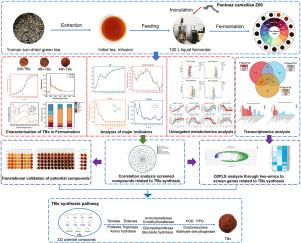综合非靶向代谢组学和转录组学发现,茶花Pantoea camelliae Z09在液态发酵中高效合成了褐蛋白
IF 6.6
1区 农林科学
Q1 FOOD SCIENCE & TECHNOLOGY
引用次数: 0
摘要
茶啡肽(TBs)是一种复杂的高分子聚合物,具有显著的健康益处和巨大的市场潜力,使其高效和大规模生产至关重要。经初步筛选,茶花Pantoea camelliae Z09液相发酵是合成结核杆菌的有效途径。在这项研究中,通过整合非靶向代谢组学和转录组学来研究高效的TBs合成。在48 h内,茶液的颜色由明亮的浅橙色变为油棕黑色,对应于结核杆菌的积累。48 h时,TBs浓度达到12.57 mg/mL,为较高水平。24、36和48 h的结构分析表明,TBs主要由酚类、蛋白质、糖和脂类组成,羟基、羧基和氨基是主要的官能团。在发酵过程中,茶浸液的pH值总体上升,与TBs溶液中观察到的变化一致。定量分析鉴定出322个关键化合物和145个与结核杆菌合成有关的差异基因,包括苯丙素、聚酮、编码水解酶、转移酶和氧化还原酶的基因。7种儿茶素(C、EC、GC、EGC、ECG、GCG和EGCG)被证实是TBs形成的主要因素,而槲皮素和葡萄糖、没食子酸、橙皮苷和芹菜素的加入进一步促进了TBs的产生。该研究为高效大规模生产TBs提供了理论指导,并为阐明微生物驱动的大分子合成建立了范例。本文章由计算机程序翻译,如有差异,请以英文原文为准。

Integrated untargeted metabolomics and transcriptomics revealed the high-efficiency synthesis of theabrownins by Pantoea camelliae Z09 in liquid-state fermentation
Theabrownins (TBs) are complex macromolecular polymers with notable health benefits and considerable market potential, making their efficient and large-scale production essential. Our preliminary screening identified Pantoea camelliae Z09 liquid-state fermentation as an effective strategy for TBs synthesis. In this study, high-efficiency TBs synthesis was investigated by integrating untargeted metabolomics and transcriptomics. Within 48 h, the tea infusion color changed from bright light orange to oily brown-black, corresponding to TBs accumulation. At 48 h, the TBs concentration reached 12.57 mg/mL, representing a relatively high level. Structural analysis at 24, 36, and 48 h showed that TBs mainly consist of phenols, proteins, sugars, and lipids, with hydroxyl, carboxyl, and amino groups as the dominant functional groups. During fermentation, the pH of the tea infusion increased overall, consistent with the changes observed in the TBs solution. Quantitative profiling identified 322 key compounds and 145 differential genes involved in TBs synthesis, including phenylpropanoids, polyketides, and genes encoding hydrolases, transferases, and oxidoreductases. Seven catechins (C, EC, GC, EGC, ECG, GCG, and EGCG) were confirmed as major contributors to TBs formation, while the addition of quercetin and glucose, gallic acid, hesperidin, and apigenin further enhanced TBs production. This study provides theoretical guidance for efficient large-scale TBs production and establishes a paradigm for elucidating microbe-driven macromolecular synthesis.
求助全文
通过发布文献求助,成功后即可免费获取论文全文。
去求助
来源期刊

LWT - Food Science and Technology
工程技术-食品科技
CiteScore
11.80
自引率
6.70%
发文量
1724
审稿时长
65 days
期刊介绍:
LWT - Food Science and Technology is an international journal that publishes innovative papers in the fields of food chemistry, biochemistry, microbiology, technology and nutrition. The work described should be innovative either in the approach or in the methods used. The significance of the results either for the science community or for the food industry must also be specified. Contributions written in English are welcomed in the form of review articles, short reviews, research papers, and research notes. Papers featuring animal trials and cell cultures are outside the scope of the journal and will not be considered for publication.
 求助内容:
求助内容: 应助结果提醒方式:
应助结果提醒方式:


